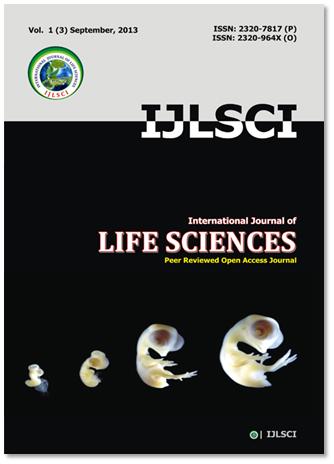Biodiversity of mycoflora in storage of Solanum melongena L. seeds.
Keywords:
Seed borne pathogen, Solanum melongena L, isolates, incidence, frequency, cultivarsAbstract
Solanum melongena L., a highly preferred vegetable amongst the weight-conscious consumers and a cash crop for poor farmers originated from healthy seed, is vulnerable to attack by diverse group of fungal pathogens in storage and spread of diseases in crop plants that adversely affect economy of poor farmers. Fungal isolations were made from twenty stored mixed seed samples of five different cultivars and individual cultivar collected form eggplant growing farmers of Vidarbha, yielded total 54 fungal species of 30 genera, including eleven species of individual genus Aspergillus, four of Fusarium, three each of Alternaria, Curvularia, Helminthosporium and Penicillium, two each of Chaetomium, Rhizopus and Trichoderma while others had single species. Deuteromycota dominated with 44.7% isolates followed by Ascomycota (39.9%). Basidiomycota had single isolate. A total of 33 to 36 isolates were confined to seeds of individual cultivar. Aspergillus nidulans, A. sulphureus, A. sydowi, A. terreus, Sporotrichum pulverulentum, Stachybotrys atra and Syncephalastrum racemosus have been recorded for first time as new records in India. Aspergilli encountered in seeds with 4 – 14% incidence excluding Aspergillus fumigatus (28%) and A. parasiticus (18%). Curvularia, Alternaria, Drechslera and Helminthosporium were detected as predominant pathogens with 11-13% incidence while Aureobasidium, Colletotrichum, Pythium and Trichothecium had little count of incidence. Of the total count of incidence, Deuteromycota dominated with 47.2% followed by Ascomycota (42.1%). Greatest count of fungal isolates and frequency incidence was recorded on blotter paper against agar plates. The standard blotter technique proved superior over agar plate. Cultivars Pusa Purple Cluster and Vaishali are moderately susceptible to fungal diseases.
Downloads
References
1. Anonymous (2011) Small fruit and vegetable. IPM-advisory – Integrated Pest Management Utah State University cooperative extension.
2. Bhajbhuje MN (1989) Investigation of the seed mycoflora associated with vegetable seeds from Vidarbha region. Ph.D. Thesis RTM Nagpur University, Nagpur.
3. Bhajbhuje MN (2013) Karyotoxicity of fungal metabolites in Solanum melongena L . Journal. Science. Information, 6 : 1-5.
4. Brakhage AA and Schroeckh V (2011) Fungal secondary metabolites in strategies of activate silent gene of clusters. Fungal Gene. Biol., 48(1) : 15-22.
5. Chukunda FR, Osakwe JA and RE Boraka (2013) Control of seed borne fungi of stored maize from Nigerian Stored Products Research Institute Port Harcount. WebPub J. Agric. Res., 1920 : 98-21.
6. EFSA (2011) Scientific Opinion on the risks for animal and public health related to the presence of Alternaria toxins in feed and food. EFSA Journal 9(10):2407.
7. FTRNR (2012) Uses and medicinal benefits of eggplant. Food Technologies Resource, News & Review http/www.foodrecap.net/health/talisary-benefits, Aug, 2011) (accessed August 5, 2013)
8. Grafware (2013) Seed mycoflora of brinjal Solanum melongena Natural Science reporting htm. (accessed August 5, 2013)
9. Habib A, Sahi ST, Ghazanfar MU and S Ali (2007) Location of seed-borne mycoflora of eggplant (Solanum melongena L.) in different seed components and impact on seed germinability. International Journal of Agricultural Biology, 9(3) : 514-516.
10. IHD (2012) Indian Horticulture Database. Source FAO website March 2012 & for India – Indian H. Database (accessed August 5, 2013).
11. Ismael JHS (2010) Isolation and identification of some fungi from certain solanaceous seeds in Sulaimania and Germian regions and their exudate effects on germination rate. Agriculture and Biology Journal of North America, 1(4): 615-619.
12. ISTA (2012) Seed Testing International ISTA News Bulletin No. 143. Zurich, Switzerland.
13. Jain PC (2008) Microbial degradation of grain, oil seeds, wood corrosion of metals and bioleaching of ores. Applied Microbiology nsdl.niscair,res.in/Microbial Dedradation pdf (assessed on25th July 2013)
14. Jyoti and CP Malik (2013) Seed deterioration: A review. International Journal of Life Sci. Biotechnology & Pharma Res., 2(3) : 373-386
15. Kulkarni AU, Chauhan AM, Kesare, UT and SM Pawar (2012) Effect of nitrogen and phosphorus sources on amylase production in seed born fungi of maize. Current Botany, 3(4): 01-04.
16. Kuri SK, Islam MR and U Mondal (2011) Antifungal potentiality of some botanical extracts against important seed borne fungal pathogen associated with brinjal seeds, Solanum melongena L. Jour. of Agricultural technology7(4);1139-1153.
17. Nagaraja O and Krishnappa M (2011) Seed borne mycoflora of Niger (Guizotia Abyssinia Cass) and its effect on germination. Indian Phytopathology, 62(4) : 210-214.
18. Nishikawa J, Kobayashi T, Shirata K, Chibana T and K Natsuki (2006) Seed borne fungi detected on stored solanaceous berry seeds and their biological activities. Journal Gen. Plant Pathology, 72:305-313.
19. Saskatchewan (2013) Guideline for seed borne diseases of pulse crops. Agricultural Knowledge Centre at 1-866-457-2377 www.agriculture.gov.sk.ca/seed-testinglabs. (Accessed August 5, 2013)
20. Shirurkar DD and NK Wahegaonkar (2012) Antifungal activity of selected plant extracts derived oils and some fungicides against seed borne fungi of maize. European Journal of Experimental Biology, 2(5) : 1693-1396.
21. Venugopalan A and P Giridhar (2012) Mycoflora associated with seeds of Bixa orellana. African Journal of Microbiology Res. 6(9):2091-2094.
22. Yago JI, Roh JH, Bae SD, Yoon YN, Kim HJ, and MB Nam (2011) The effect of seed borne mycoflora from Sorghum and Foxtain Millets on germi
Downloads
Published
How to Cite
Issue
Section
License
Copyright (c) 2013 Authors

This work is licensed under a Creative Commons Attribution-NonCommercial-NoDerivatives 4.0 International License.
Open Access This article is licensed under a Creative Commons Attribution 4.0 International License, which permits use, sharing, adaptation, distribution and reproduction in any medium or format, as long as you give appropriate credit to the original author(s) and the source, provide a link to the Creative Commons license, and indicate if changes were made. The images or other third party material in this article are included in the article’s Creative Commons license unless indicated otherwise in a credit line to the material. If the material is not included in the article’s Creative Commons license and your intended use is not permitted by statutory regulation or exceeds the permitted use, you will need to obtain permission directly from the copyright holder. To view a copy of this license, visit http://creativecommons.org/ licenses/by/4.0/











